Important Shortcut Keys
| Toggle Fullscreen: | F11 (most browsers) |
| Undo Move: | Ctrl+Z |
| Deal Again: | F2 |
| Close Dialogue Box: | Esc |
Spider Solitaire
Hello and welcome to the Spider Solitaire App! Spider Solitaire is a popular patience game, mostly because of its difficulty level, which makes it an interesting logical puzzle. This version of the game is available online and free for everyone to use.
Overview
Like most other patience games, Spider Solitaire is played by one player, and the objective is to sort cards by rank and suit and place them in the foundation fields at the top of the game board. What distinguishes Spider Solitaire from other variants of the game is that here, the player has to assemble piles of ordered cards on the game board and the stack can only be transferred onto the foundation field if it is complete from Ace to King. This differs from other solitaire games (like Klondike or Freecell), in which the player moves cards to foundation fields one by one, starting with the Aces. Moreover, Spider Solitaire is played with two decks, unlike other forms of solitaire that are played with only one.
The board consists of ten fanned-down columns, on which cards are laid face down, except for the topmost cards (this means that the card on the top of the stack, i.e., the one that is not covered by any other card, is actually at the bottom when you look at the game board, since the columns are fanned down). The player has to arrange the cards by suit and rank by moving them between columns. Only stacks of cards that are sorted by suit and sequence can be moved at once. Otherwise, there are no limits on the cards being moved (unlike in Freecell, for example, where the size of the moveable stack depends on the number of free cells available). In addition to the ten columns, the board also consists of eight foundations that are in the top-right corner of the board, and a stock that is found in the top-left corner of the board.
Instructions
General Rules of Spider Solitaire
- Whenever there are no more suitable moves available, the player can draw cards from the stock. Drawing cards from the stock proceeds as follows: the player needs to make sure that there are no empty columns. If there is an empty column, then cards cannot be drawn from the stock. This means that it is possible to lock yourself into a situation where there are not enough cards on the board to be able to put at least one in each column, and you cannot draw more cards from the stock because some columns are empty. Try to avoid this situation and never let the number of cards on the board drop below ten. If there are no empty columns, the player then draws ten cards from the stock and places one card face up on top of every column.
- A card (or a stack of cards) can only be moved from one column to another if the card(s) being moved (or the card at the bottom of the moved stack) is one rank lower than the card on which it is being placed. The suit of these two cards does not matter; however, if the cards have a different suit, then you will not be able to move them together later on.
- You can place any card in an empty column.
- For a stack to be movable, all cards need to be in sequence and have the same suit.
- When you create a stack of thirteen cards of the same suit from Ace to King, you must collect these cards and then move them to a foundation field at the top of the game board. The game does this automatically.
- The game is played with two decks, i.e. with 104 cards.
- Spider Solitaire has a distinct scoring system. You start with a score of 500, and every move (including undos) subtracts 1 point from your score. Also, whenever you assemble a full stack and the cards are transferred to a foundation field, you will receive 100 points. As a result, the objective of the game is to put all cards in the foundation fields using the least possible number of moves. It also follows that undoing a move is allowed, and is treated the same as any other move. Undoing moves is especially useful when you play at higher difficulty levels.
- It is important to keep building sequential stacks, especially with cards of the same color. It is also important to uncover as many cards as possible - even if this sometimes means creating stacks with multiple colors. Draw cards from the stock only when there are no more useful moves left, or when the moves that are left are certain to bring mess, rather than order. Finally - and this is very important for higher difficulties - clear one of the columns as soon as possible. Having an empty column greatly increases your ability to sort cards in other columns, as you can use it to temporarily store any card or stack of cards.
The game is played in three variants, which have varying difficulty levels.
- 1-suit Spider Solitaire is a game that is played only with cards of a single suit. This is the easiest difficulty because every sequential stack built by the player is moveable, and it is almost always solvable.
- 2-suit Spider Solitaire is more difficult because it is played with two suits. Usually, these are two suits of opposite colors. That is, one suit is black (Clubs or Spades) and one suit is red (Hearts or Diamonds). In this variant of the game, you can build stacks using both available suits; however, the stacks are only moveable if they are of a single suit. Although they are considerably harder to solve than 1-suit games, 2-suit games are still often solvable, so long as you put enough thought and effort into it.
- 4-suit Spider Solitaire is the hardest, and may even initially seem impossible to win - but eventually, with a lot of patience and determination, you may be able to solve some of the games. Its difficulty comes from the fact that the game uses two complete decks, and so there are four suits to play with. As in the lower difficulty settings, you can place a card, regardless of its suit, on another card as long as the destination card has a rank that is higher by one. However, in order to build moveable stacks, you still need cards of the same suit. This means that, for any given card, there are only two cards out of 104 in the entire game that you can place it on to build a moveable stack. And there is little chance that one of these two cards is going to actually be available on the board. As a result, a flawless player can only win up to around 1 in 3 games.
How to play Spider Solitaire – Solving Example
Spider Solitaire has three difficulty levels. Here is an example of how to successfully start the easiest difficulty level, 1-suit Spider Solitaire. This variant of the game uses two decks of cards of a single suit.
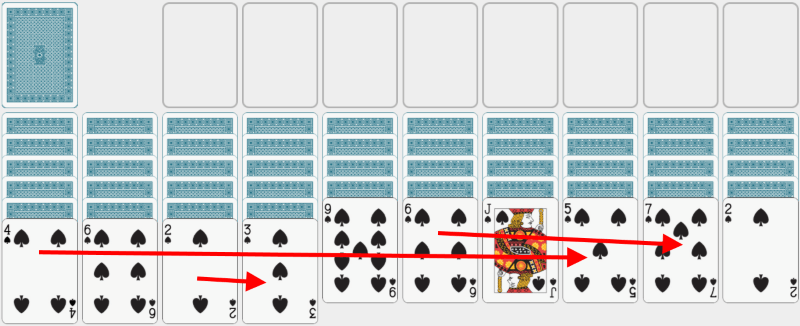 With a 1-suit, it is often possible to make a lot of moves right from the start. In this example, we can make three moves immediately. Let’s move the 4 onto the 5, the left-most 2 onto the 3, and the right-most 6 onto the 7. |
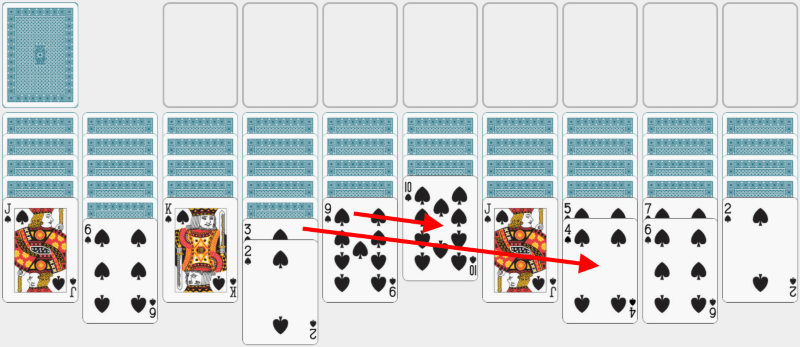 In the second round, we can move the stack consisting of 2 and 3 located in the fourth column onto the 4 in the eighth column. Let’s also move the 9 onto the 10. |
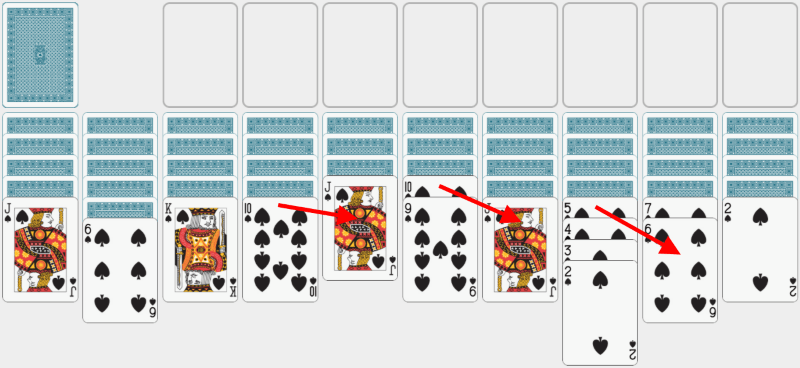 Now, we’ll move the 10 in the fourth column onto the Jack in the fifth column. We will also move the stack of 9 and 10 in the sixth column onto the Jack in the seventh column. Finally, let’s move the 4-card stack in the eighth column onto the 6 in the ninth column. |
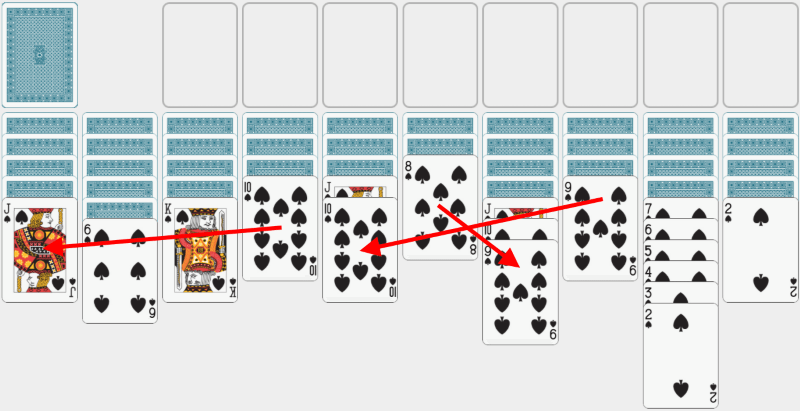 We keep on sorting cards out. Place 10 from the fourth column onto the Jack. Then, let’s move the 8 onto the 9 in the seventh column. Finally, move 9 from the eighth column onto the 10 in the fifth column. |
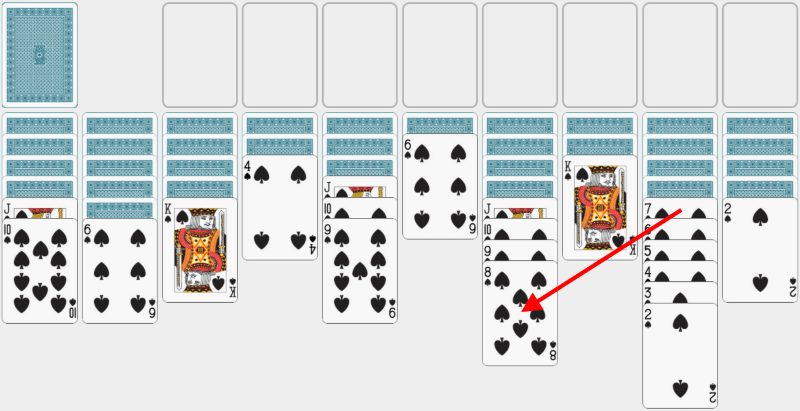 Now, we can make a big move and get the entire stack in the ninth column and place it on the 8 in the seventh column. |
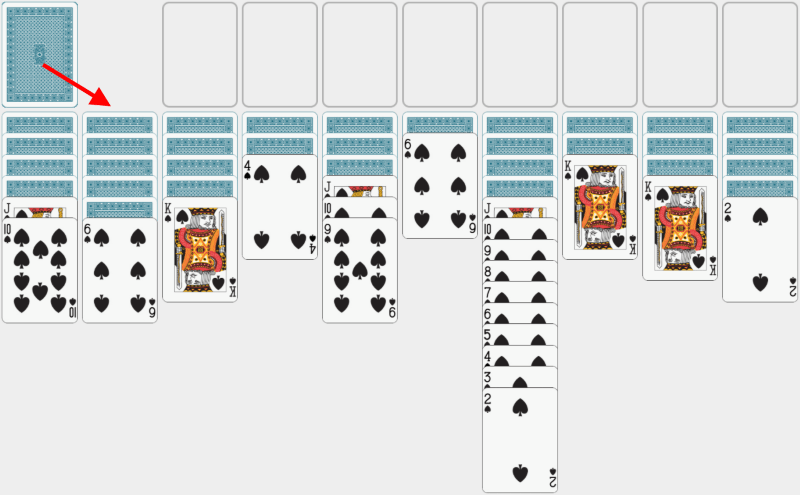 Unfortunately, at this stage, there are no more useful moves that we can make. The only thing left to do is to draw cards from the stock. |
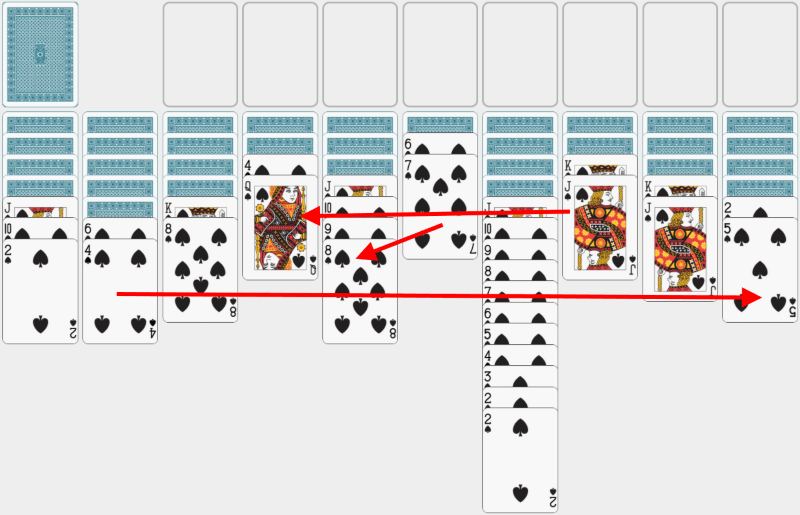 Let’s clean up the mess that has been created by the newly-arrived cards. Place the 4 from the second column onto the 5 in the tenth column. Move the Jack from the eighth column onto the Queen in the fourth column. Finally, let’s move the 7 in the sixth column onto the 8 in the fifth column. |
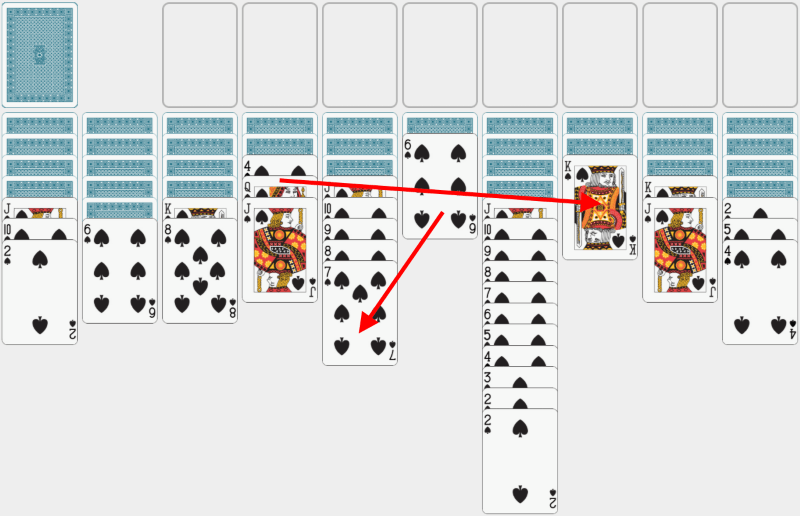 Move the Queen and the Jack from the fourth column onto the King in the eighth column. Let’s also move the 6 from the sixth column onto the 7 in the fifth column. |
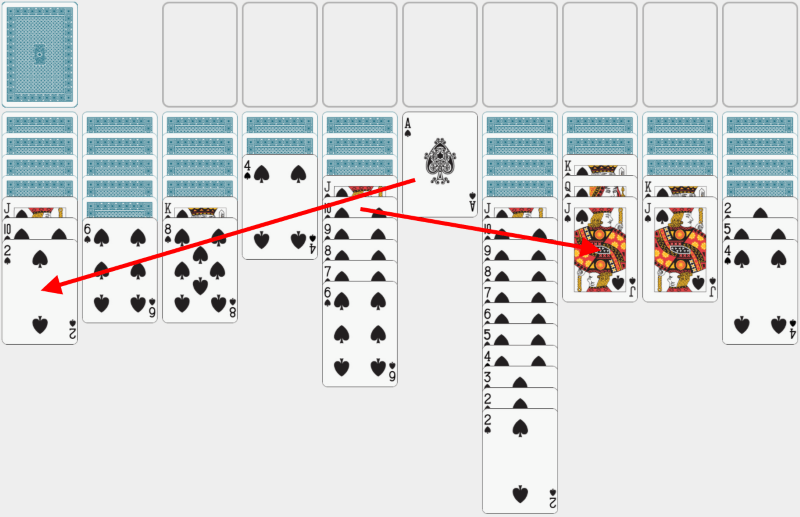 We can now move the last card from the sixth column – the Ace – and place it on the 2 in the first column. Next, let’s pick up the 10 in the fifth column and the rest of the stack above it, and place it on the Jack in the eighth column. Now we have just started building our first full stack – from King to Ace. |
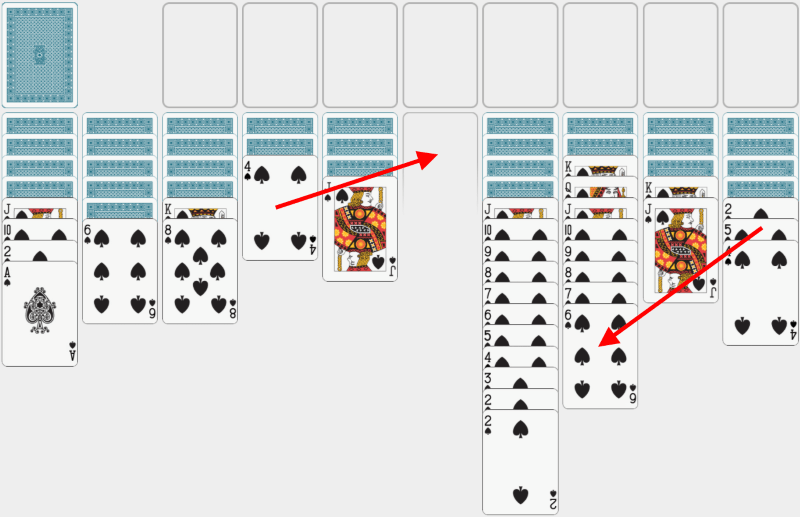 In this move, we continue to build our first full stack by placing 5 and 4 from the last column onto the 6 in the eighth column. Let’s also move the 4 in the fourth column into the empty sixth column. |
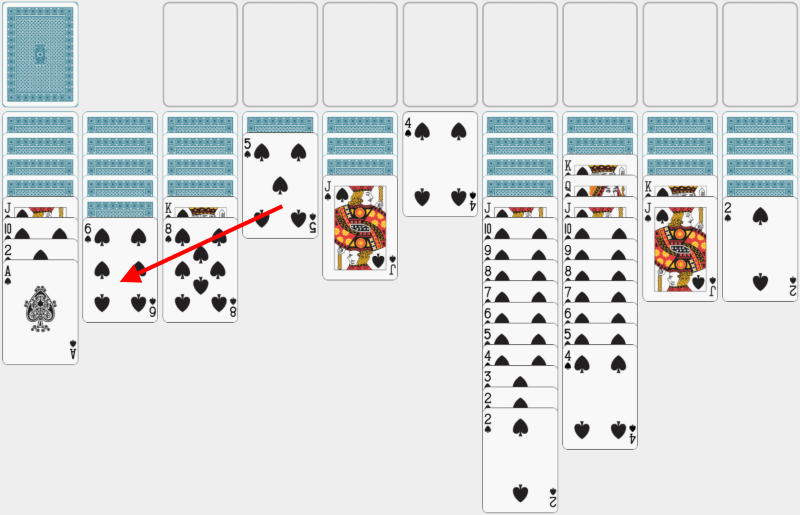 Unfortunately, we cannot continue building our first full stack because we do not have a 3 available. Instead, though, we can move the 5 in column four and place it on the 6 in the second column. |
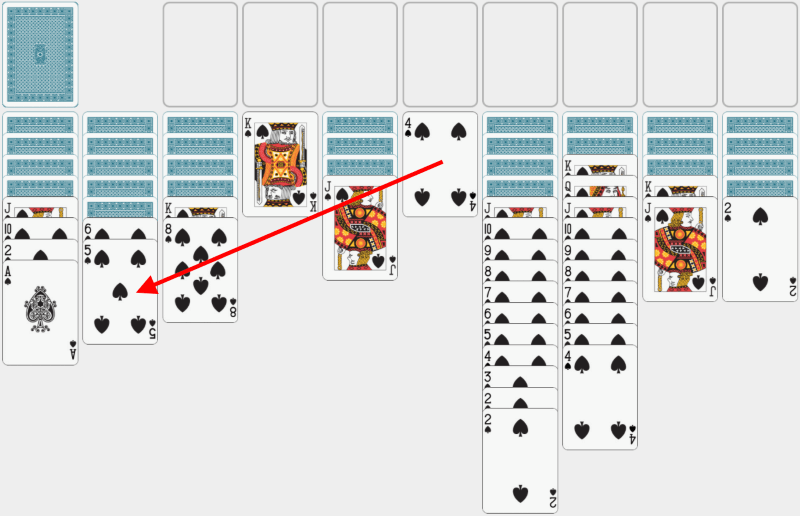 Then, we can move the 4 from column six onto the 5 in the second column. Now, we once again have an empty column. |
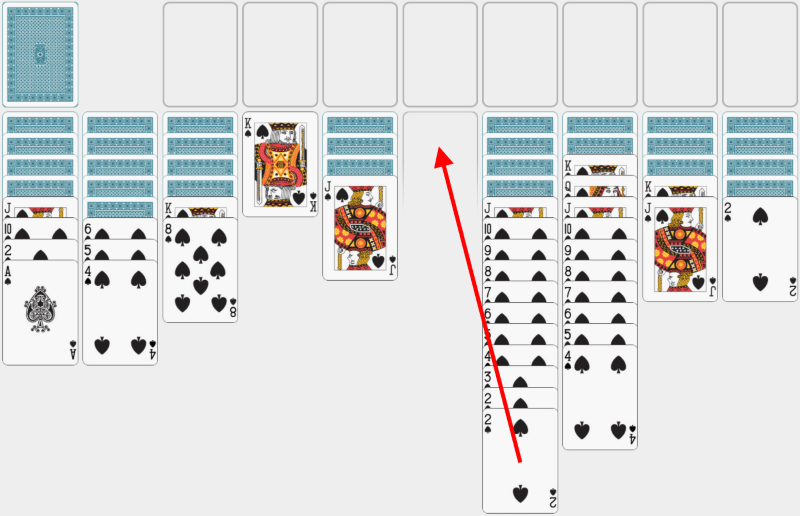 We can use the empty column to store the 2 from the seventh column. This 2 was blocking a lot of very helpful moves. |
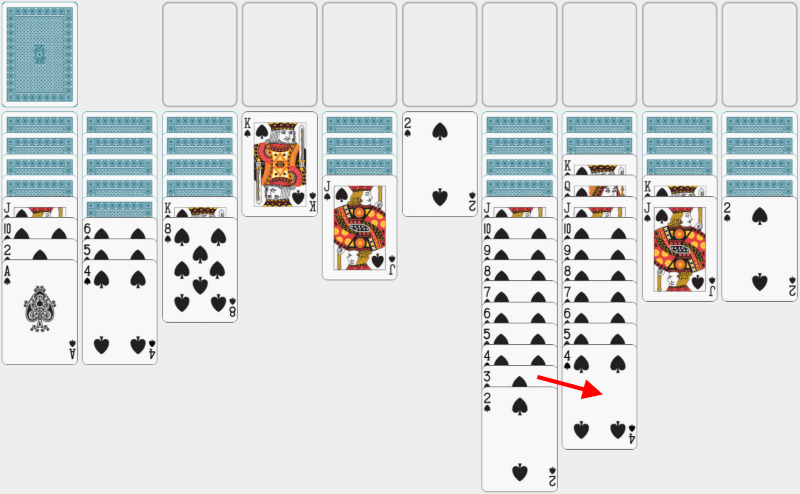 Now, we can continue building our first full stack. Let’s move the 3 in the seventh column onto the 4 in the eighth column. |
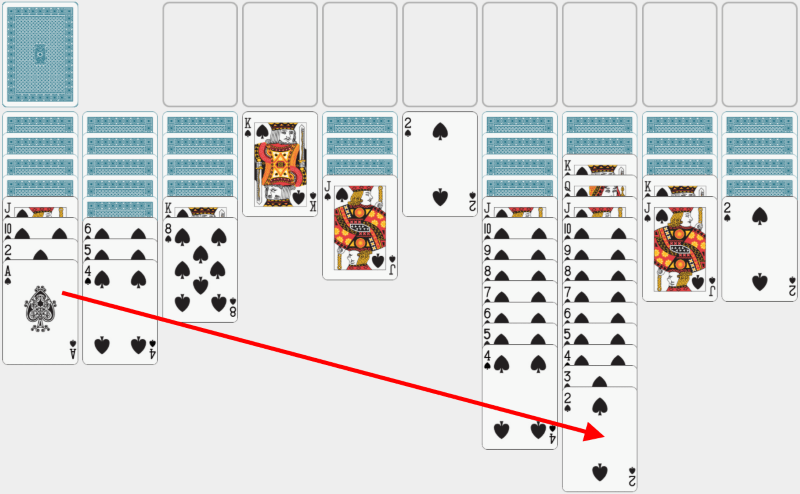 And finally, to complete our first full stack, let’s move the Ace onto the 2 in the eighth column. The entire stack will move to the foundation field above. |
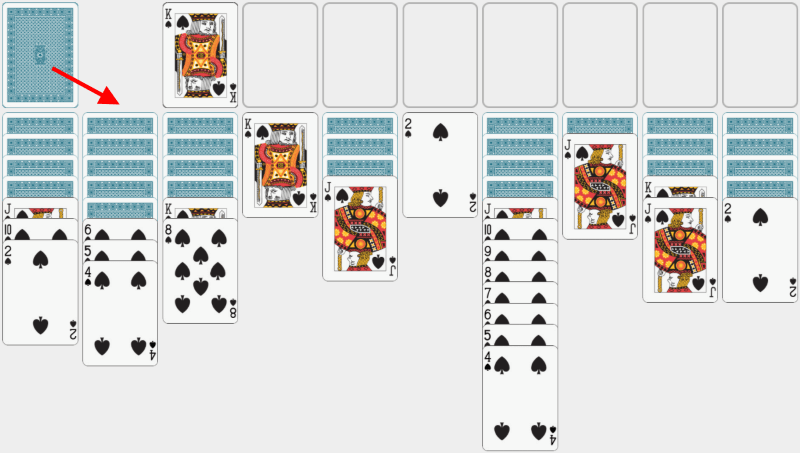 Now, there are no useful moves that we can make, so the only thing left for us to do is draw cards from the stock. |
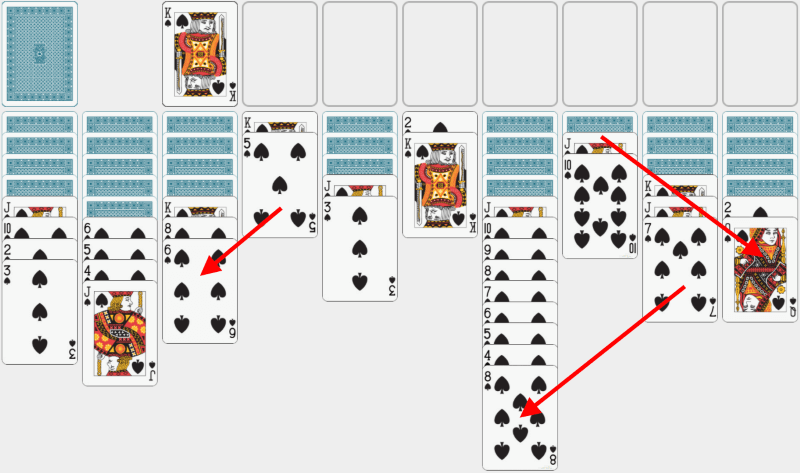 Now, we can put the new cards in order. Let’s put the 5 in the fourth column onto the 6 in the third column. Let’s move the Jack and the 10 from the eighth column onto the Queen in the tenth column. And finally, let’s move the 7 in the ninth column onto the 8 in the seventh column. |
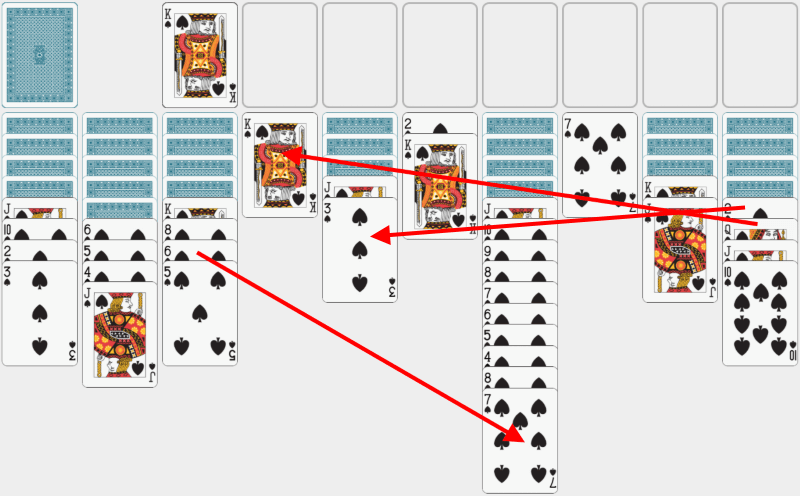 Move the 6 and 5 from the third column onto the 7 in the seventh column. Then, let’s move the stack starting with the Queen from the tenth column onto the King in the fourth column. Finally, let’s move the 2 that was underneath the Queen and move it onto the 3 in column five. |
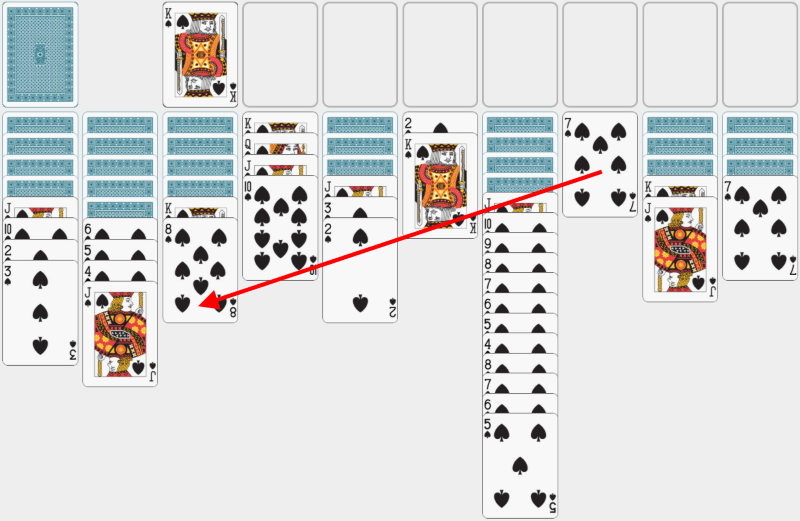 Now, move the 7 from the eighth column onto the 8 in the third column. |
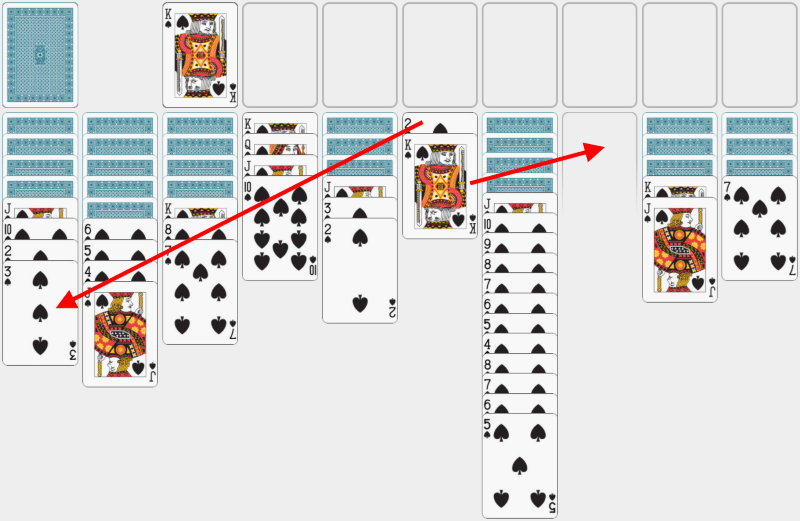 Let’s disassemble column six. We can place the King in the empty column eight, and the 2 in column one. |
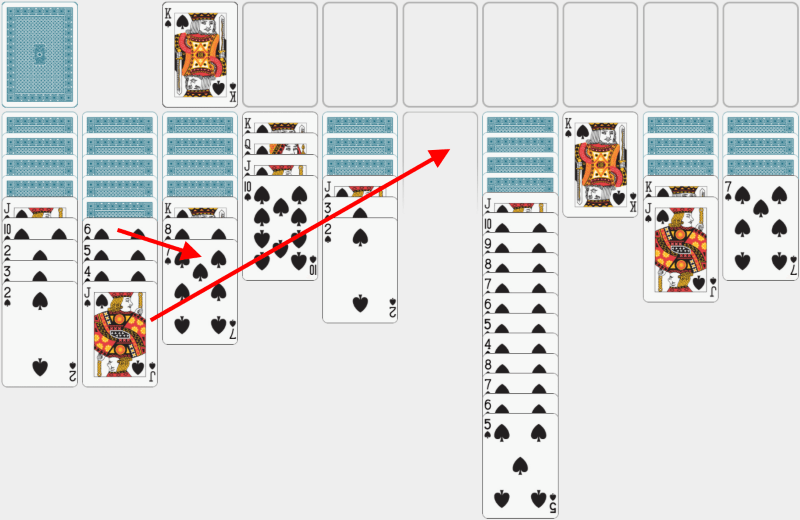 Then, we’ll focus on column two. We can move the Jack into the empty column six, and the stack starting with the 6 onto the 7 in the third column. |
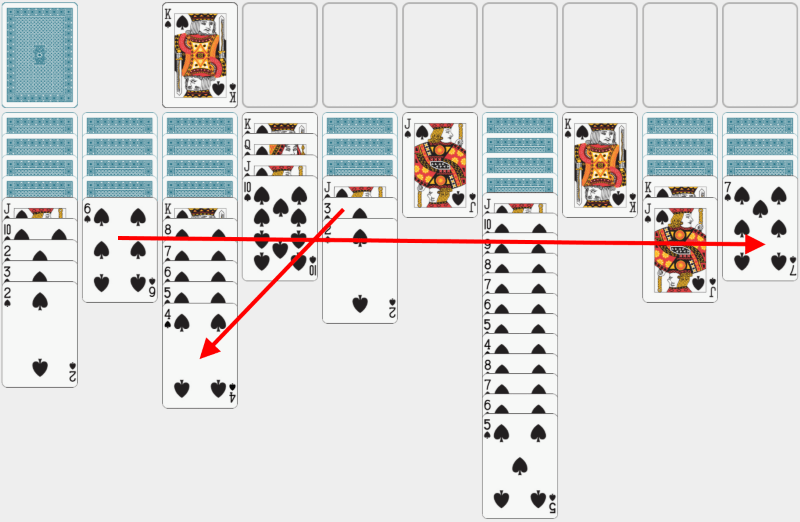 We keep putting the cards on the board in order. Move 2 and 3 from column five onto the 4, and then move the 6 from the second column onto the 7. |
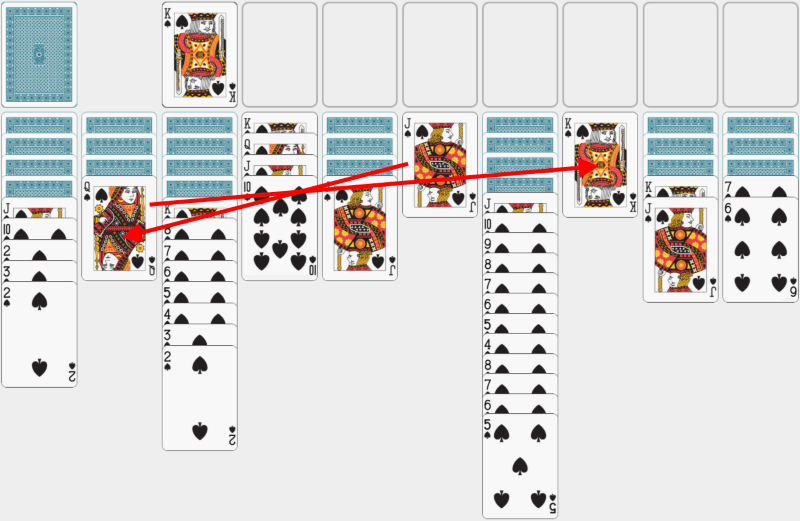 This time, we can place the Jack from the sixth column onto the Queen from column two and move them together onto the King in column eight. |
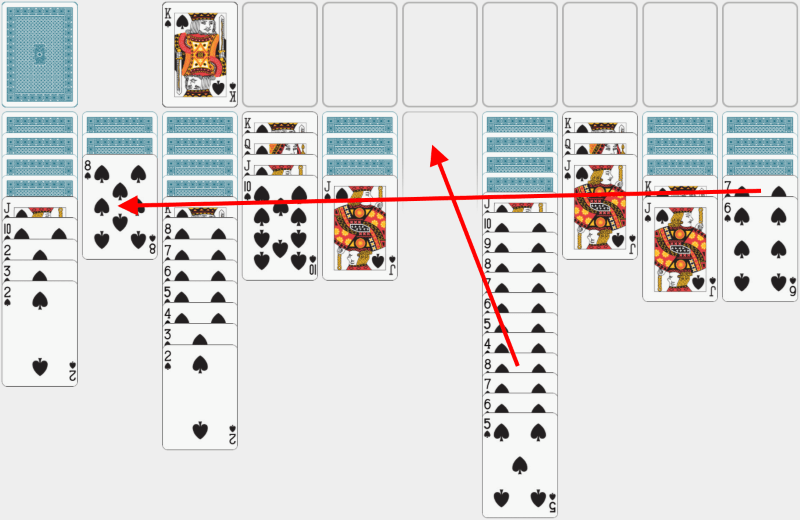 Move the 6 and 7 from the tenth column to column two and pick up the stack from column seven, starting with the 8, and place it in the empty column six. |
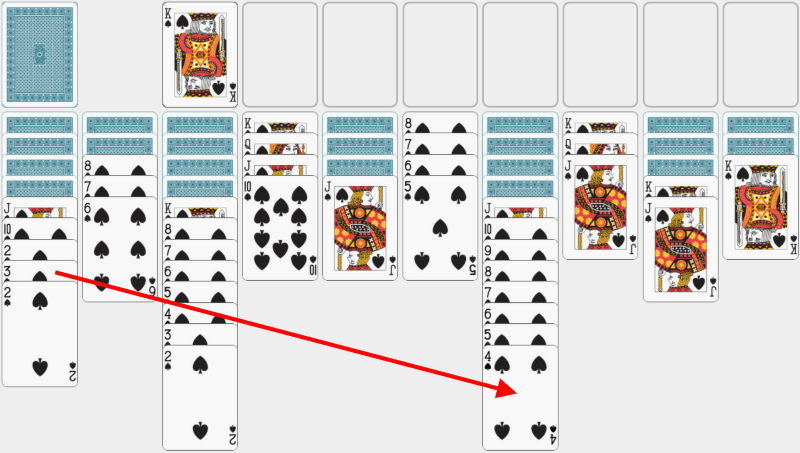 Finally, we can move the 2 and 3 from column one into column seven. Notice that the board now seems to be quite in order. All we need is an Ace to complete a full stack. This looks like the beginning of an easy game! |
The second difficulty level is played with two decks: one of a red suit and one of a black suit. This is often called 2-suit Spider Solitaire. Below, you can find an example of how to successfully begin such a game:
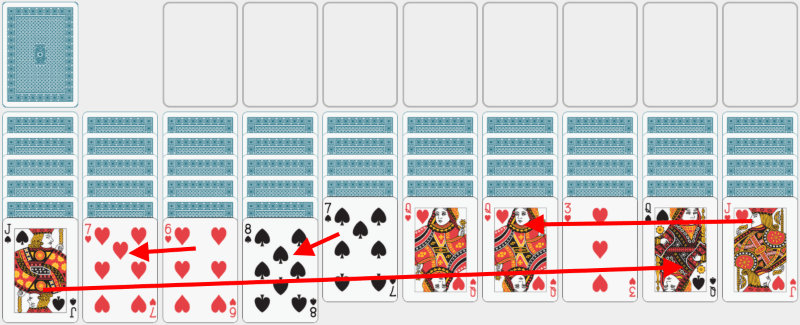 We start by sorting cards of the same color. Move the 6 of Hearts to the second column, the 7 of Spades onto the 8, the Jack of Hearts onto the right-most Queen of Hearts, and the Jack of Spades onto the Queen of Spades. |
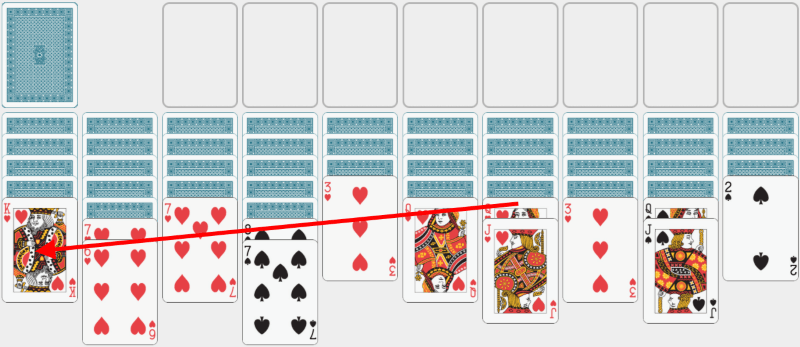 Now, that the King of Hearts has been revealed, we can place the Queen and the Jack on it. |
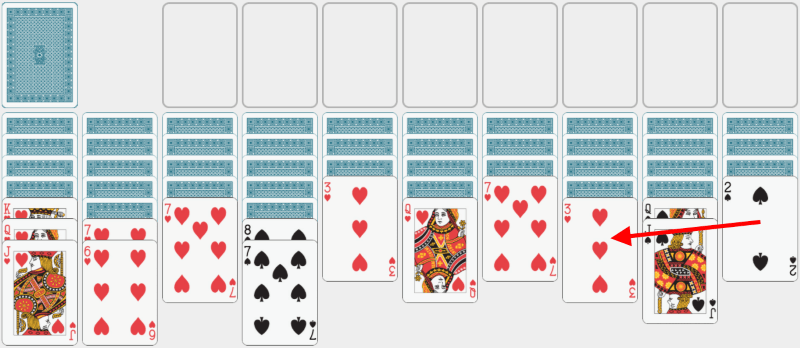 Unfortunately, there are no more moves that sort out the cards of the same color, but we still need to uncover more cards so that we have a bit more to work with. Let’s store the 2 of Spades on the 3 of Hearts in the eighth column. |
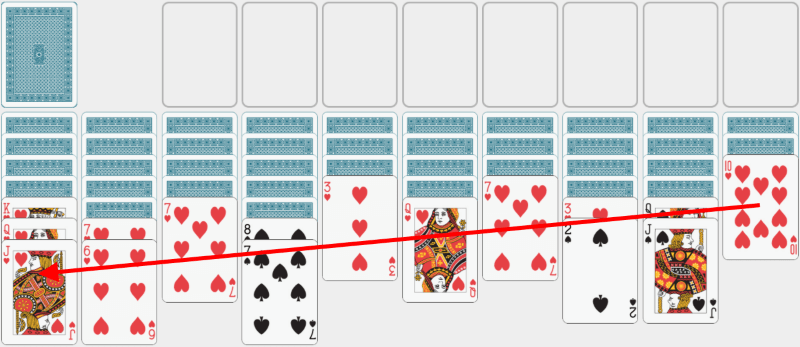 What is revealed is the 10 of Hearts, which we can then immediately move onto the Jack of Hearts in the first column. |
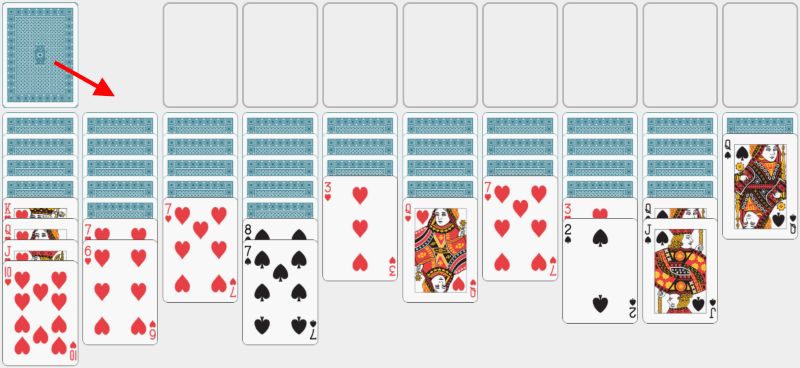 Unfortunately, there is nothing useful that we can do on the board now. The only thing left for us to do is draw more cards from the stock. |
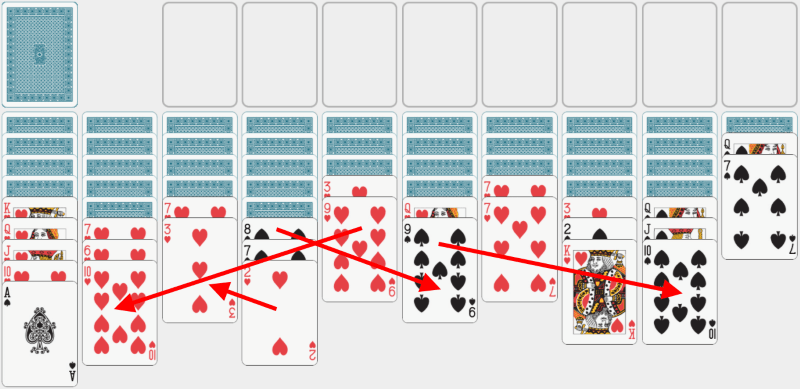 Now, we have a lot of new cards and a lot of possible moves. We’ll first place the 2 of Hearts from column four onto the adjacent 3 of Hearts. This unblocks the two-card stack of 7 and 8 of Spades, which we can move onto the 9 of Spades in the sixth column. Then, we can move the newly-created stack of 7, 8, and 9 onto the 10 in the ninth column. Also, let’s move the 9 of Hearts from the fifth column to the second column. |
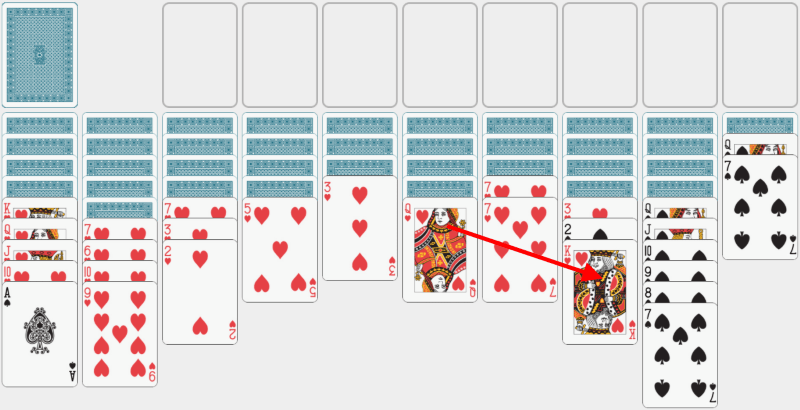 Now that the Queen has been freed, we can place it on the King of Hearts. |
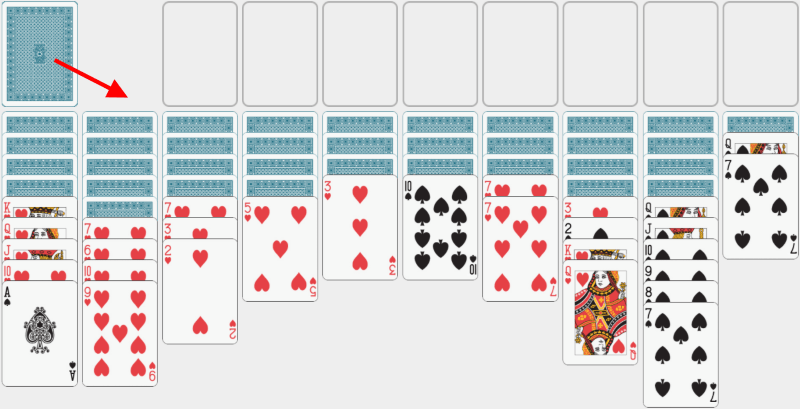 Again, there are no more useful moves left on the board, so we need to draw more cards from the stock. |
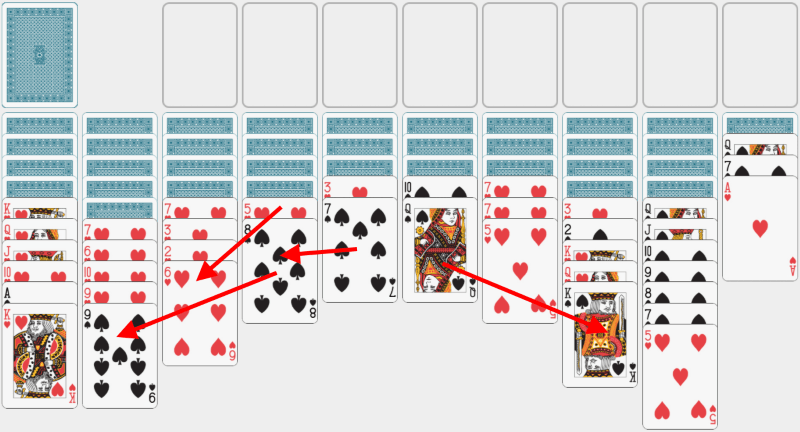 The board gets a bit cluttered, but fear not! We are going to solve this mess. Let’s start by moving the 7 of Spades from column five onto the adjacent 8 of Spades, and then move them both onto the 9 of Spades in the second column. The 5 of Hearts in column four has just been made available, and so we can move it to column 3 and place it on the 6 of Hearts there. Finally, let’s move the Queen from the sixth column onto the King in the eighth column. |
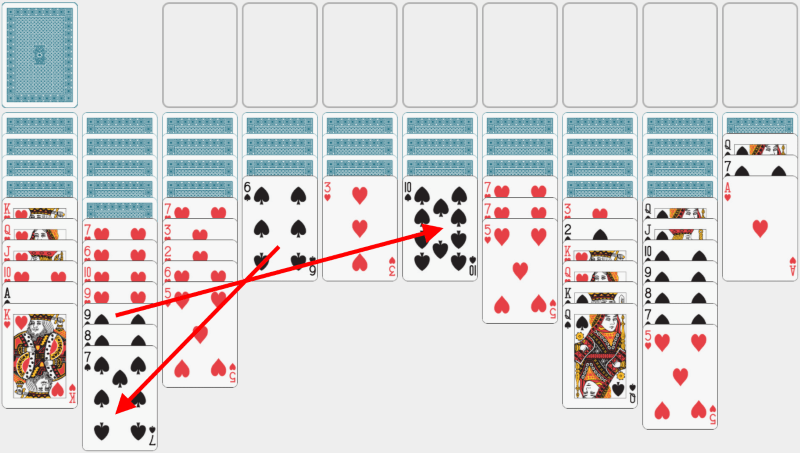 Now, we can place the six from the fourth column onto the 7 in column two. Then, we’ll move the entire four-card stack onto the 10 of Spades in the sixth column. |
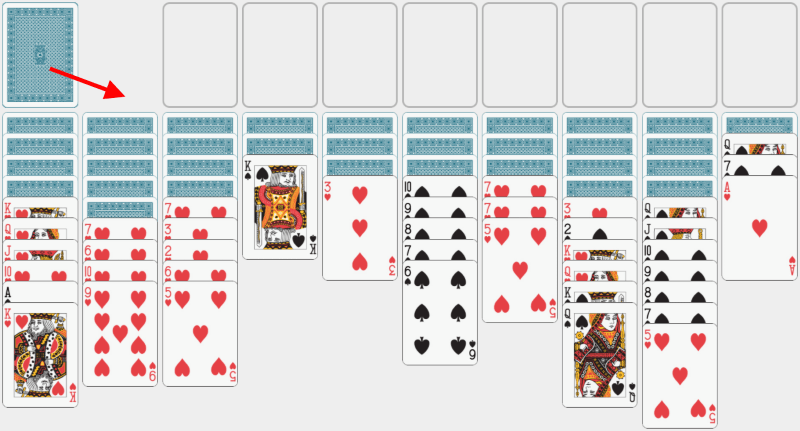 One possible move is to move the 5 of Hearts from column nine to column six, and then move the stack starting with the Queen of Spades from stack nine to stack four. This will reveal a card, but will also clutter up column six. It is actually legal to make those moves in order to find out what happens - and if they are not useful, we can undo them. This is because the score in Spider Solitaire depends on the number of moves, and undos are counted as regular moves - thus, they are completely legitimate. In this case, it turns out that the best thing to do is draw cards from the stock. |
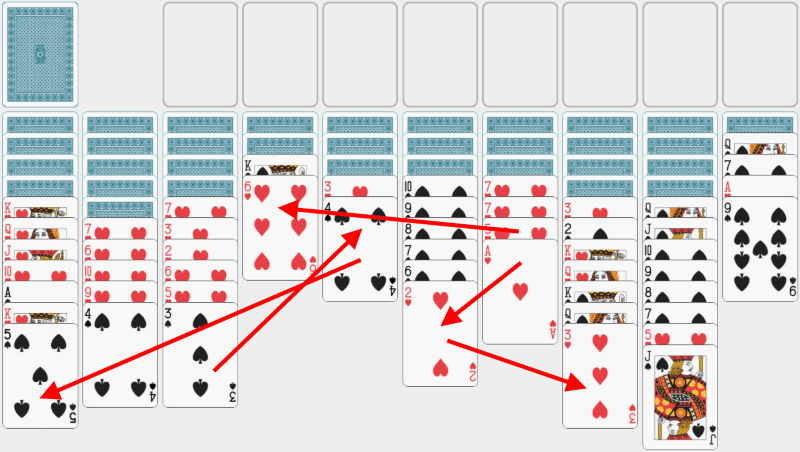 New cards and new moves! Let’s start with collecting the 3 of Spades and the 4 of Spades from columns three and five, and then placing them on the 5 in column one. Similarly, we can take the Ace and the 2 from the sixth and seventh columns and place them on the 3 in column eight. This releases 5 in column 7, which we can then place onto the 6 in the fourth column. |
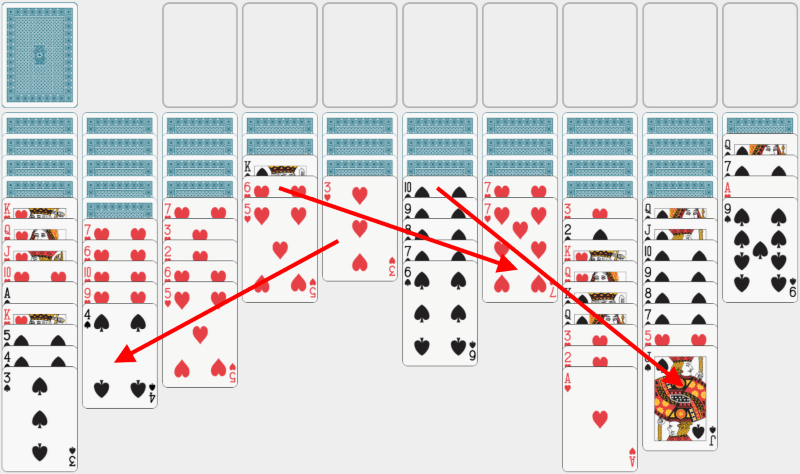 Now, we can place the 5 and 6 from column four onto the 7 in column seven. Also, let’s move the stack starting with 10 in the sixth column onto the Jack of Spades in column nine. Since we are now out of same-color moves, we can try to uncover some cards by placing the 3 of Hearts from column five onto the 4 in column two. |
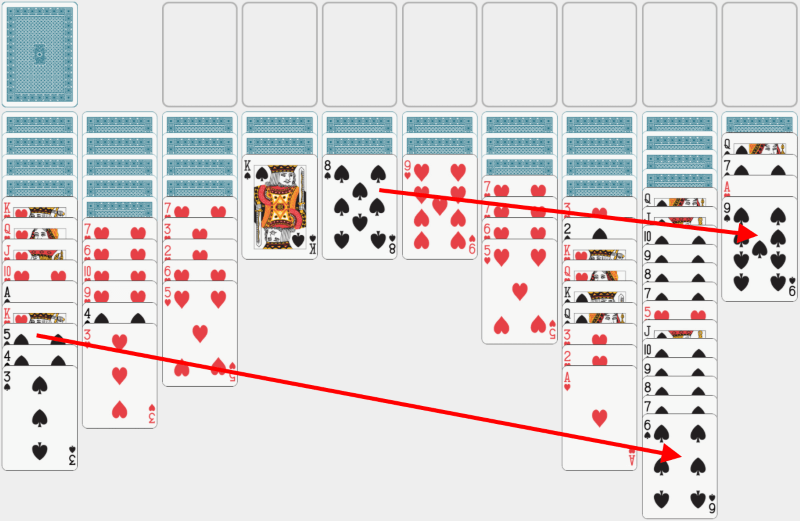 Place 3, 4, and 5 from column one onto the 6 in the ninth column. Move the 8 onto the 9 in column ten. |
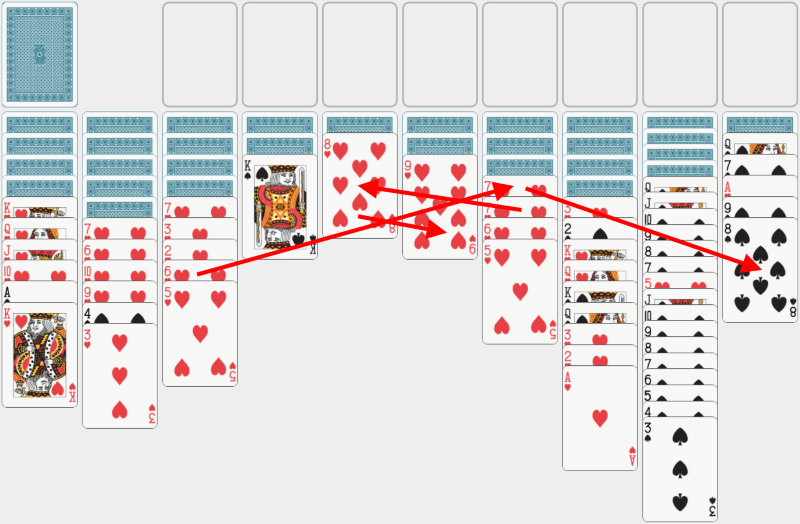 And now we have another combo of moves! First, let’s move the 5, 6, and 7 from the seventh column onto the 8 in column five, collect it, and then move the enlarged stack onto the 9 in column six. We’ll use the other 7 in the seventh column to place the 5 and 6 from column three on it. Then, we’ll move these three cards onto the 8 of Spades in column ten. |
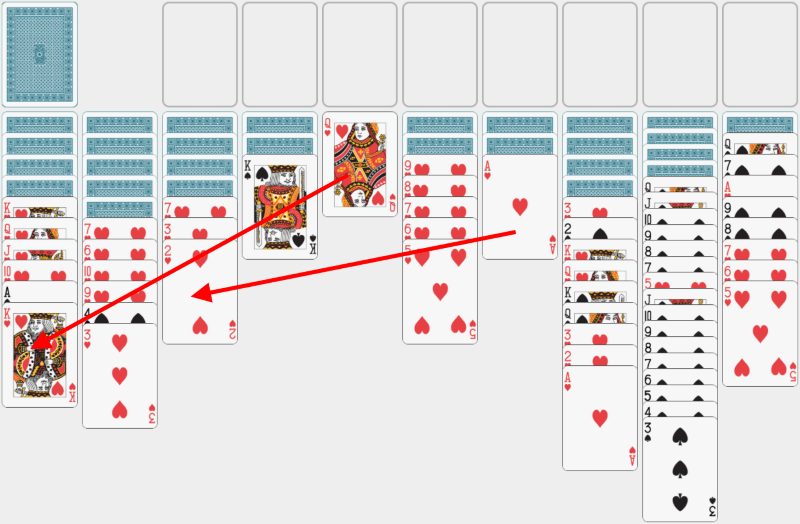 Finally, we are going to have an empty column! This is very important because an empty column can be extremely useful, since we can place any card in it. We will soon use it to arrange more cards the way that we want them. But first, we have to get there. So, let’s put the Queen onto the King in column one. Let’s also move the Ace from column seven onto the 2 in the third column. |
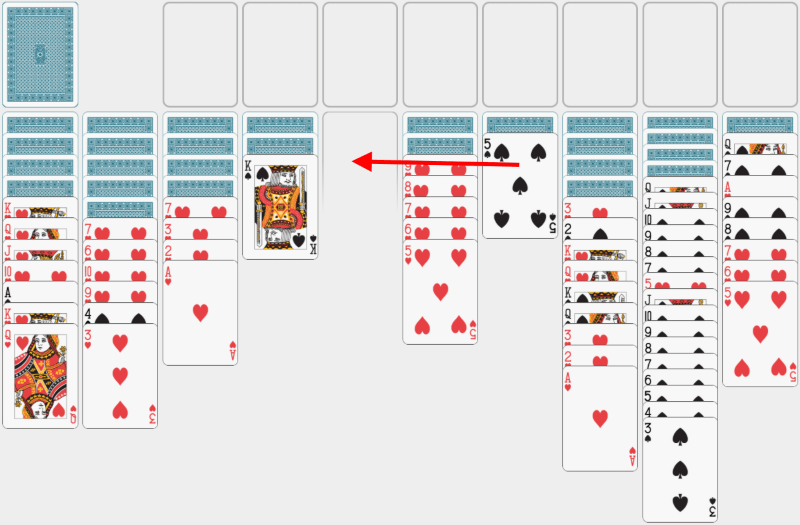 We first use our newly-empty column to make another empty column. That is, we’ll move the 5 of Spades. |
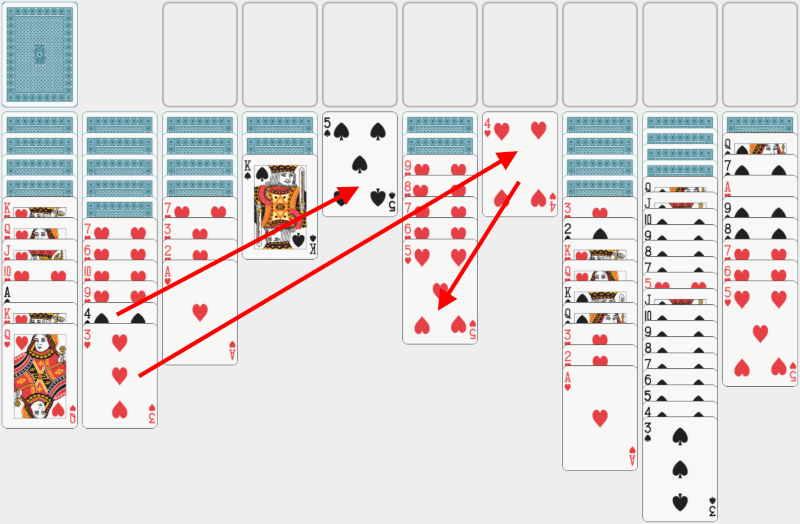 Let’s focus on the second column. First, move the 3 onto the 4 in column seven, pick up both cards, and move them onto the 5 in column six. Then, move the just released 4 onto the 5 in column five. |
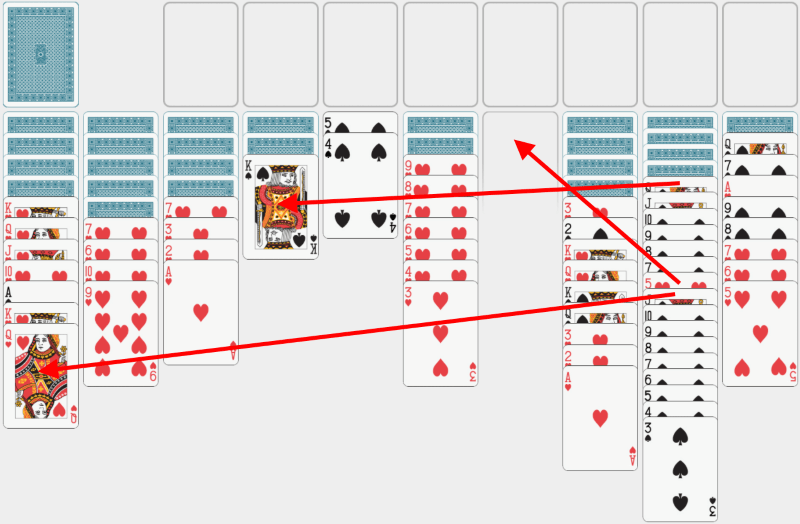 Now, we focus on column nine. First, let’s move the stack beginning with the Jack of Spades onto the Queen in the first column. Then, move the 5 of Hearts into the empty column seven. Finally, let’s move the stack starting with the Queen of Spades onto the King in column four. |
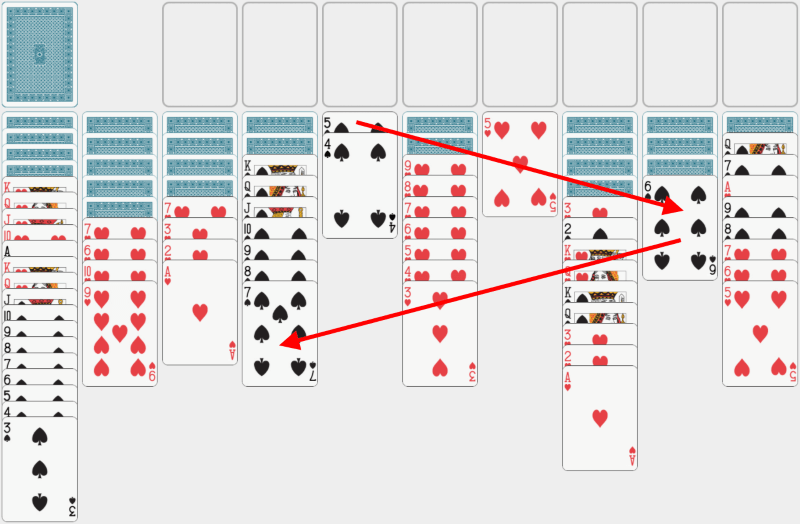 We want to build a full stack in column four. To do that, we’ll take 4 and 5 from column five, put them on the 6 in the ninth column, then collect the entire three-card stack and place it on the 7 in column four. |
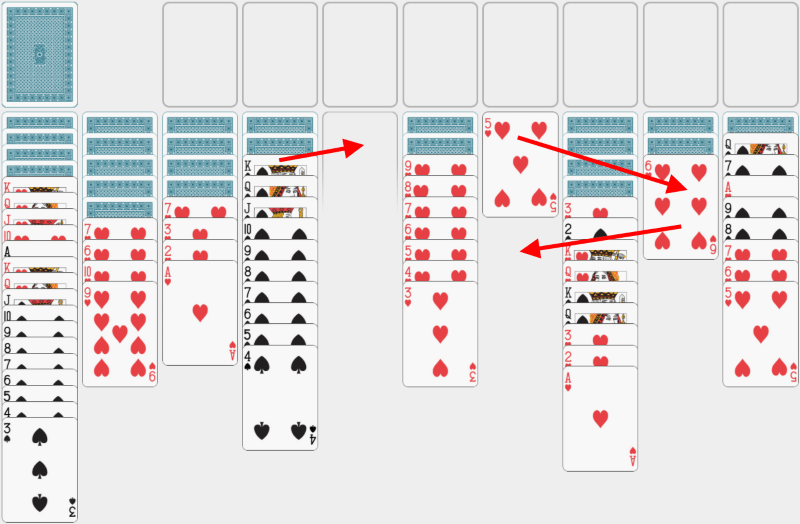 Move the stack in column four over to the fifth column. Also, move the 5 from column seven onto the 6 in column nine, then move both cards back to column seven. |
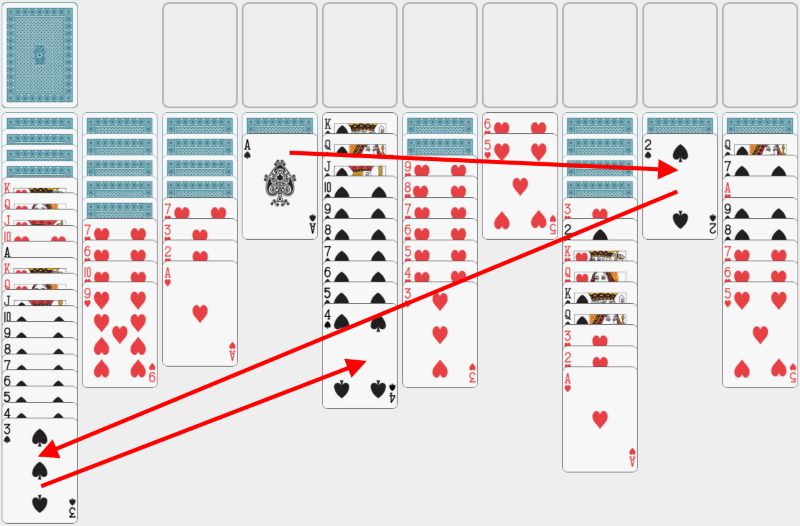 We can finally finish building our first full stack. To do so, we need to take the newly discovered Ace in column four and place it on the 2 in column nine, take both cards and move them to the first column, and then take the sub-stack of Ace, 2, and 3 and move it over to column five. Our first full stack is ready! |
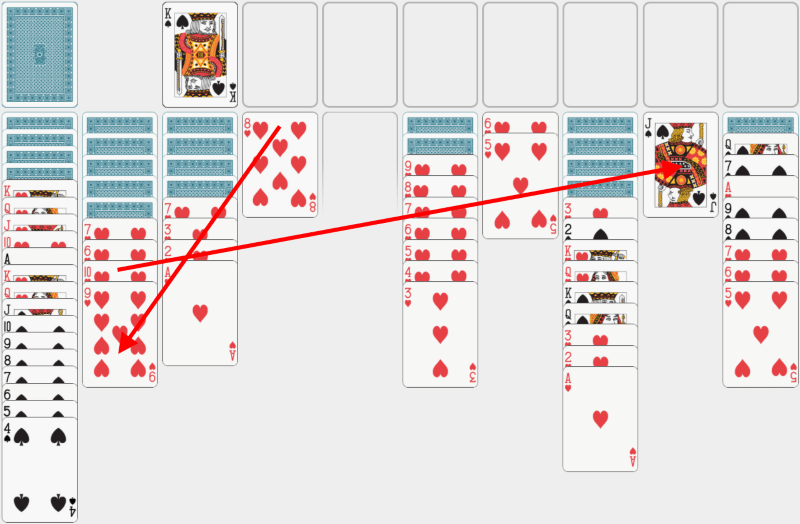 Now, we can move the 8 from the fourth column and place it on the 9 in column two. Next, we can take 8, 9, and 10 from column two and place them on the Jack in column nine. |
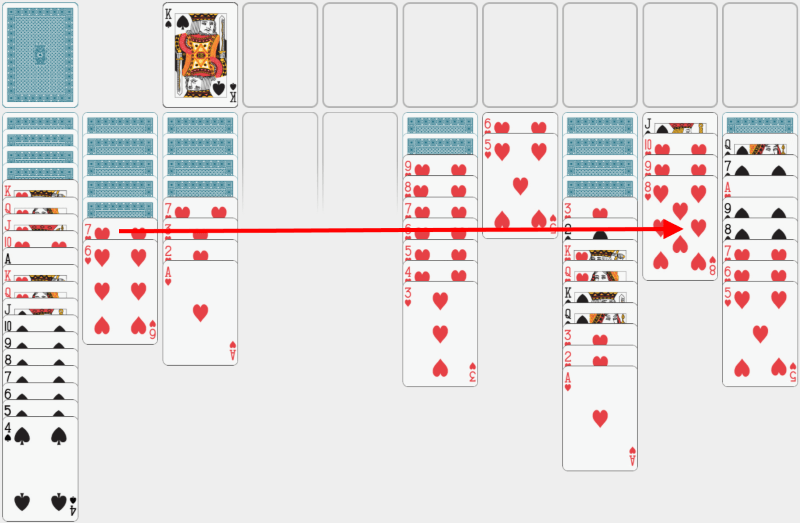 Notice that we now have two empty columns! We are virtually indestructible, and it will be hard to lose the game now. We can continue by moving 6 and 7 from the second column onto the 8 in the ninth column. |
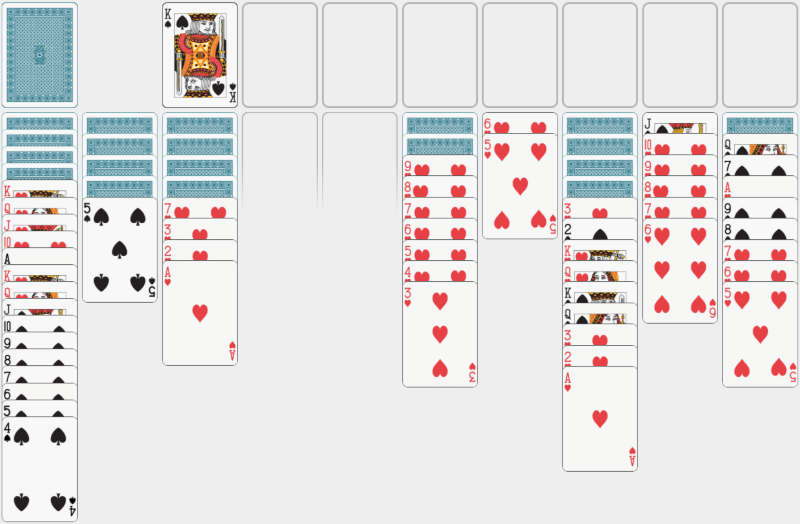 Look at this beautiful board! Do you have an idea what to do next? Can you figure out how to achieve three empty columns? |
The most difficult game mode is playing with two full decks - that is, with four colors. This difficulty level is for really good players, and so we decided not to include it in this elementary tutorial. You’ll have to figure out how to play 4-suit Spider Solitaire on your own!
History
Spider Solitaire originated in 1947 when it was first played using (surprise, surprise!) real cards, and not a computer. Rumor has it that Spider Solitaire was a favorite patience game of US President Roosevelt. The game was always quite popular because of its difficulty and potential for strategic thinking and analysis. Its first common computer implementations appeared in the early 1990s with the Microsoft Windows 3 operating system. A Unix version was developed even earlier (in 1989), but this version was not as popular. Since then, Spider Solitaire has come bundled with most major distributions of operating systems, with the most popular versions being those that came with Windows 7 and XP. This online version of Spider Solitaire is inspired by those iterations.
Copyright © 2021-2025 simiade.com. All rights reserved. | Terms and Conditions | Privacy Policy